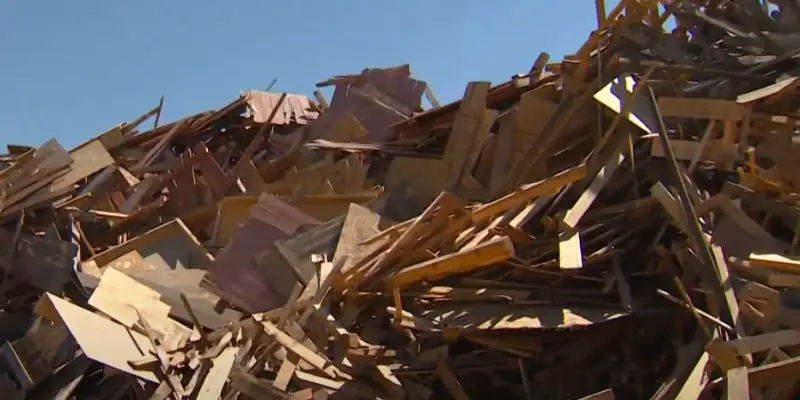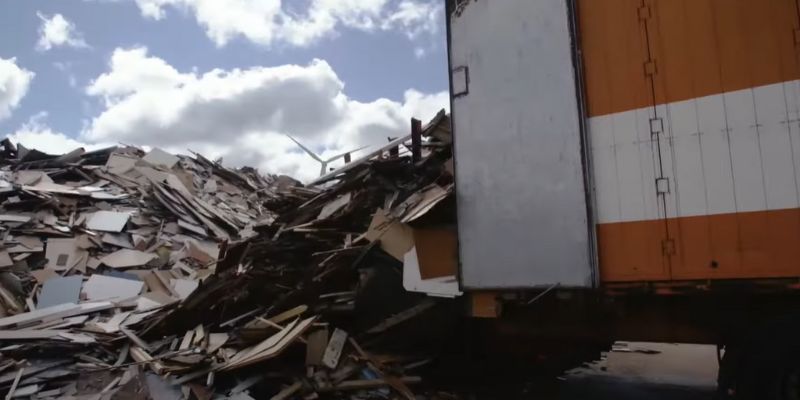Yes, wood can be recycled. Recycled wood can be used for various products and construction materials, helping to reduce waste and conserve resources.
Recycling wood also helps to minimize the need for new logging, which can have negative impacts on forests and ecosystems. Recycling wood is an important sustainability practice that contributes to environmental conservation. By repurposing wood waste, we can reduce landfill disposal and the need for new timber harvesting, which helps to preserve natural habitats.
Additionally, recycled wood can be used to create new furniture, flooring, and other products, providing a sustainable alternative to virgin materials. Not only does wood recycling reduce environmental impact, but it also supports a circular economy by maximizing the utility of existing resources. Overall, recycling wood is a beneficial practice that promotes environmental responsibility and resource efficiency.
Recycling Wood: Why It Matters
Recycling wood is essential for the environment and waste management. By reusing and recycling wood products, we can reduce the impact on natural resources and minimize the amount of wood waste that ends up in landfills. Understanding the importance and impact of wood recycling is crucial for sustainable practices and environmental preservation.

Importance Of Wood Recycling In Waste Management
Wood recycling plays a significant role in waste management by diverting wood waste from landfills. When wood is recycled, it can be used to create new products, reducing the need for virgin materials and conserving natural resources. Effectively managing wood waste through recycling helps minimize the environmental footprint associated with traditional wood disposal methods.
Impact Of Wood Wastage On The Environment
Wood wastage has a considerable impact on the environment, contributing to deforestation and habitat destruction. When wood is improperly disposed of, it can release harmful greenhouse gases as it decomposes in landfills, further exacerbating climate change. By recycling wood, we can mitigate these negative environmental effects and work towards a more sustainable future.
Benefits Of Reusing And Recycling Wood
Reusing and recycling wood offer numerous benefits, including reducing the demand for new timber, lowering carbon emissions, and promoting a circular economy. By finding new uses for reclaimed wood, we can conserve energy and resources while minimizing the environmental impact of wood production. Additionally, repurposing wood products extends their lifespan, contributing to a more sustainable and efficient use of natural materials.
Identifying Recyclable Wood Types
Wood is a renewable and valuable resource that can be recycled to reduce waste and environmental impact. However, not all types of wood are recyclable. It’s important to understand the characteristics of recyclable wood items and how to prevent contamination in wood recycling processes.
Differentiating Between Recyclable And Non-recyclable Wood
Not all wood products are suitable for recycling. It’s essential to differentiate between recyclable and non-recyclable wood to ensure the effectiveness of recycling efforts. Recyclable wood typically includes clean and untreated wood items, such as pallets, crates, lumber, and construction waste. On the other hand, non-recyclable wood often consists of painted, treated, or chemically treated wood, which can pose challenges in the recycling process.
Common Characteristics Of Recyclable Wood Items
Recyclable wood items share several common characteristics that make them suitable for recycling. These include untreated, clean, and solid wood materials that are free from contaminants such as paint, stains, and chemical treatments. Additionally, dimensional lumber, plywood, and wooden pallets are commonly identified as recyclable wood items due to their structural integrity and ease of repurposing.
Preventing Contamination In Wood Recycling
To maintain the quality and sustainability of wood recycling, it’s crucial to prevent contamination. This involves separating recyclable wood from non-recyclable materials, ensuring that contaminated wood does not enter the recycling stream. Proper labeling and clear identification of wood products can help prevent contamination and facilitate efficient recycling processes.
Can You Recycle Wood: Eco-friendly Solutions
Wood is a versatile and natural material, but the disposal and recycling of wood products can have a significant impact on the environment. Understanding the eco-friendly solutions and methods of recycling wood is crucial for sustainable waste management. Let’s delve into the eco-friendly practices and processes of recycling wood and its industrial applications.
Understanding The Recycling Process For Wood Materials
Wood recycling involves the collection and processing of wood waste to create useful products. The process typically includes the sorting, chipping, and shredding of wood materials to produce wood chips, mulch, or particleboard. Reclaimed wood can also be processed for reuse in construction, furniture, and other applications, reducing the demand for virgin timber.
Methods Of Recycling Wood For Industrial Use
Industrial wood recycling methods include mechanical and chemical processes. Mechanical recycling involves grinding, shredding, and chipping wood waste to produce wood chips, sawdust, or fibers for various industrial applications. On the other hand, chemical recycling utilizes solvents or heat to break down wood components to create new products such as adhesives, composite materials, or fuel.
Eco-friendly Practices In Wood Disposal
Eco-friendly wood disposal practices focus on minimizing waste and maximizing reuse. Source reduction, recycling, and composting are key strategies to divert wood waste from landfills. Additionally, implementing sustainable forestry practices and promoting the use of reclaimed wood contribute to a more eco-friendly approach to wood disposal and recycling.

Recycling Wood At Home
Recycling wood at home can be a rewarding and environmentally friendly practice. Whether you’re looking to repurpose old wooden furniture or responsibly dispose of wood scraps from DIY projects, there are several ways to ensure that wood is recycled properly at the household level.
Diy Projects Involving Recycled Wood
Repurposing wood for DIY projects gives old wood a new lease on life. From creating unique furniture pieces to decorative wall art, there’s no shortage of creative projects that can be tackled with recycled wood. The versatility of wood makes it an ideal material for DIY enthusiasts looking to create one-of-a-kind items for their homes.
Tips For Proper Wood Recycling At The Household Level
- Separate treated and untreated wood to ensure proper recycling methods are followed.
- Remove any metal or plastic attachments from the wood before recycling.
- Avoid mixing wood with other materials in recycling bins to streamline the recycling process.
- Consider composting untreated wood scraps for a sustainable solution.
Local Wood Recycling Programs And Guidelines
It’s essential to be aware of local wood recycling programs and guidelines to ensure compliance with regulations and best practices. Many communities offer drop-off locations or curbside pickup services for wood recycling, making it convenient for households to participate in eco-friendly disposal of wood waste.
Challenges In Wood Recycling
Wood recycling presents a unique set of challenges that hinder the efficient reuse of this valuable resource. Addressing these difficulties is crucial in ensuring that wood waste is effectively repurposed, thus minimizing its environmental impact. From the complexities of wood waste separation to economic barriers, the wood recycling industry faces a multitude of obstacles that must be overcome to achieve sustainable resource management.
Addressing The Difficulties In Wood Waste Separation
One of the primary challenges in wood recycling is the separation of different types of wood waste. Variations in size, shape, and contamination levels make it difficult to efficiently sort and process wood materials for recycling. Implementing advanced sorting technologies and deploying trained personnel to properly categorize wood waste is essential in streamlining the collection and separation process.
Overcoming The Economic Challenges Of Recycling Wood
The economic viability of wood recycling poses significant hurdles for the industry. High transportation costs, limited markets for recycled wood products, and the upfront investment required for processing equipment contribute to the economic challenges. To combat these obstacles, innovative business models and partnerships with manufacturers and construction companies can create new revenue streams and stimulate demand for recycled wood products.
Strategies To Improve The Wood Recycling Rate
- Developing educational campaigns to raise awareness about the importance of wood recycling
- Enhancing collaboration between municipalities, waste management companies, and recycling facilities to streamline the collection and processing of wood waste
- Investing in research and development to create new technologies for more efficient wood waste separation and processing
- Encouraging the incorporation of recycled wood materials in construction projects through legislative incentives and green building certifications
Innovations In Wood Recycling
Innovations in wood recycling have led to significant advancements in the industry, allowing for more efficient and sustainable processing of wood waste. These innovations encompass advanced technologies, breakthrough treatments, and successful case studies, all contributing to the enhancement of wood recycling capabilities.
Advanced Technologies Enhancing Wood Recycling Capabilities
The emergence of advanced technologies has revolutionized the wood recycling process, enabling the efficient reclamation of wood waste. Innovations such as waste wood shredding machines and automated sorting systems have streamlined the collection and segregation of different types of wood, making the recycling process more effective and environmentally friendly.
Breakthrough Treatments For Contaminated Or Treated Wood
Breakthrough treatments have been developed to address the recycling of contaminated or treated wood, which was previously a significant challenge. Bio-remediation techniques and thermal treatment processes have been successfully implemented, allowing for the safe and efficient recycling of wood that was previously considered non-recyclable.
Case Studies: Success Stories In Wood Recycling Initiatives
Several successful case studies showcase the positive impact of wood recycling initiatives. These include partnerships between recycling facilities and construction companies to recycle wood waste, as well as the implementation of innovative technologies to reclaim and repurpose wood materials. These case studies serve as inspiring examples of how effective wood recycling initiatives can contribute to a healthier environment and a more sustainable future.
Frequently Asked Questions Of Can You Recycle Wood
How Do You Get Rid Of Wood?
You can get rid of wood by recycling, repurposing, or disposing of it responsibly at designated facilities. Contact local waste management or recycling centers for guidance. Avoid burning treated or painted wood, as it can release harmful chemicals into the air.
Can You Put Wood In General Waste Bin?
No, wood should not be put in the general waste bin. It can be recycled or used for composting. Disposing of wood properly helps reduce waste and benefits the environment.
Where Can I Dispose Of Wood In Austin?
You can dispose of wood in Austin at the Texas Disposal Systems Environmental Collection Center.
What Woods Cannot Be Recycled?
Most woods, except for treated, painted, or coated woods, can be recycled efficiently. Wood that has been treated or painted may contain harmful chemicals, making it unsuitable for recycling. It’s important to properly dispose of treated woods to avoid environmental damage.
Conclusion
Recycling wood is not only beneficial for the environment but also for reducing waste. By reusing and repurposing wood, we can contribute to sustainability efforts and reduce our carbon footprint. It’s important to be mindful of the types of wood we recycle and consider the potential impact on the environment.


